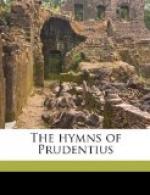105 Cf. Rev. xvii. 8: “The beast
that thou sawest was, and is not;
and is about to come
up out of the abyss, and to go into perdition.”
109 Cf. 2 Thess. ii. 4: “The son of
perdition, who opposeth and
exalteth himself above
all that is called God, or that is worshipped;
so that he as God sitteth
in the temple of God, showing himself that
he is God.”
127 The phrase rorem subisse sacrum would
suggest baptism by
sprinkling, except that
Prudentius uses the word loosely elsewhere.
Immersion was undoubtedly
the general practice of the early Church,
“clinical”
baptism being allowed only in cases of necessity.
128 The anointing with oil showed that the catechumen
was enrolled
among the spiritual
priesthood, and with the unction was joined the
sign of the Cross on
the forehead.
VII
1 This entire hymn is used in the Moz. Brev.,
divided into fifteen
portions for use during
Lent.
27 The word sacerdos here, as in ix. 4,
is used in the sense of
“prophet”;
but in both passages there is some idea of the exercise
of priestly functions.
Elijah may be called “priest” from his
having
offered sacrifice on
Mount Carmel, and David from his wearing the
priestly ephod as he
danced before the Ark.
69 The old editors discuss these lines with much
gravity, and mostly
come to the conclusion
that “locusts” were “a kind of bird,
of
the length of a finger,
with quick, short flight”; while the “wild
honey” was not
actual honey at all, but “the tender leaves of
certain trees, which,
when crushed by the fingers, had the pleasant
savour of honey.”
76 A gloss on one of the Vat. MSS. adds:
“This is not authorised; for
John merely baptized
with water, and not in the name of the Father,
Son and Holy Ghost;
therefore his baptism was of no avail, save that
it prepared the way
for Christ to baptize.” Many of the Fathers,
however, while expressly
affirming that John’s baptism differed
from that of Christ,
allowed that the stains of sin were washed
away by the former.
St. Chrysostom draws this distinction: “There
was in John’s
baptism pardon, but not without repentance; remission
of sins, but only attained
by grief.”
100 The story of Jonah, as a type of the Resurrection,
is one of the
most frequent subjects
of the frescoes of the Catacombs. In one very
ancient picture, a man
in a small boat is depicted in the act of
placing the prophet
in the very jaws of the whale.
115 Two stanzas are omitted in the text, which
depict the sufferings
of Jonah with a wealth
of detail not in accordance with modern
taste. For the
sake of giving a complete text, we append them here:—




